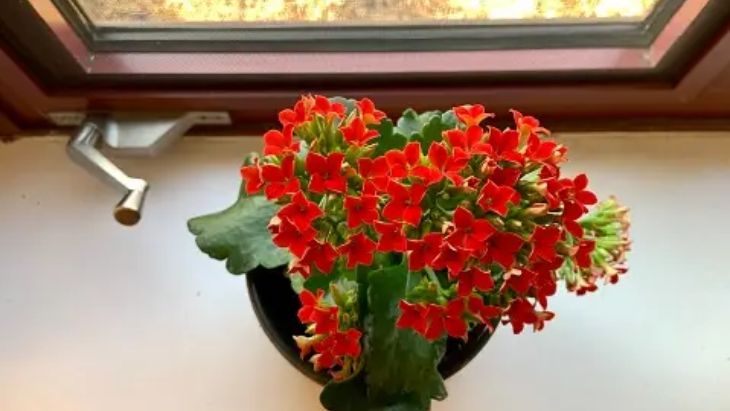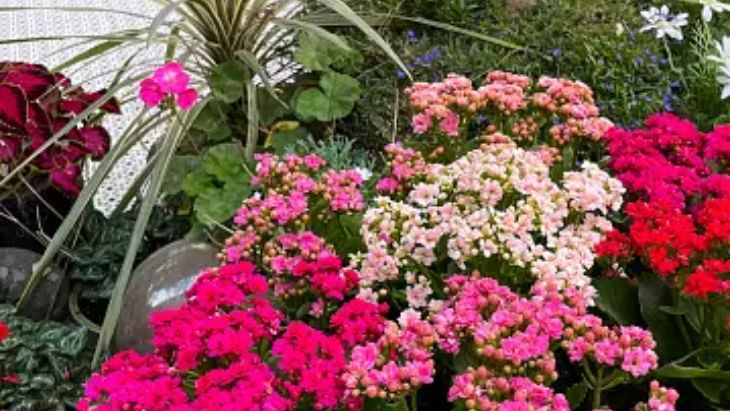Kalanchoe is a popular succulent plant known for its vibrant, long-lasting flowers. It is relatively easy to grow and care for, making it a great choice for both indoor and outdoor gardening. Here are some guidelines to help you grow and care for Kalanchoe:
How to care for kalanchoe
Light
Kalanchoe prefers bright, indirect sunlight. Place it near a window with filtered light or in an area with bright, indirect light. Avoid exposing it to direct sunlight for extended periods as it can scorch the leaves.
Temperature
Kalanchoe thrives in moderate temperatures between 60°F and 75°F (15°C and 24°C). Protect it from drafts and extreme temperature fluctuations, especially during winter.
Watering
Water your Kalanchoe thoroughly but allow the top inch (2.5 cm) of soil to dry out between waterings. Overwatering can cause root rot, so it’s essential to provide good drainage. Avoid letting the plant sit in water-filled saucers.
Soil
Use a well-draining soil mix for succulents or cacti. You can either purchase a pre-made mix or make your own by combining regular potting soil with perlite or coarse sand to enhance drainage.
Fertilization
Feed your Kalanchoe with a balanced, water-soluble fertilizer during the growing season (spring and summer) every 2-4 weeks. Follow the instructions on the fertilizer package for the correct dosage.
Pruning
To encourage bushier growth, pinch back the tips of the Kalanchoe stems. This will promote branching and result in a fuller plant. You can also remove faded flowers and leggy growth to maintain an attractive appearance.
Propagation
Kalanchoe can be easily propagated from stem cuttings. Take a 3-4 inch (7-10 cm) cutting from a healthy plant, allow it to callous over for a day or two, and then place it in a well-draining potting mix. Keep the soil slightly moist until the cutting establishes roots.
Flowering
Kalanchoe is known for its colorful, long-lasting flowers. To encourage blooming, expose the plant to about 12-14 hours of darkness per day for 4-6 weeks before the desired flowering period. This can be achieved by covering the plant with a dark cloth or placing it in a dark room.
Indoor vs. outdoor care
If you choose to keep your Kalanchoe outdoors, make sure it is in a sheltered spot protected from strong winds and excessive rain. Move it indoors during cold winter months if temperatures drop below 50°F (10°C).

Types of kalanchoe
There are several different types of Kalanchoe plants, each with its own unique characteristics and growth habits. Here are some popular types of Kalanchoe:
- Kalanchoe blossfeldiana: This is the most common and widely available variety. It features thick, succulent leaves and produces clusters of colorful, long-lasting flowers in shades of red, orange, pink, yellow, and white. It is often used as a potted plant or in garden beds.
- Kalanchoe thyrsiflora (Paddle Plant or Flapjack Plant): This variety has large, paddle-shaped leaves that are grayish-green with red or purple edges. It grows in a rosette form and produces tall, erect flower spikes with small, yellowish-green blooms.
- Kalanchoe tomentosa (Panda Plant or Chocolate Soldier): This variety is known for its fuzzy, silvery-green leaves with brownish-red markings. The leaves have a velvety texture, resembling the fur of a panda, hence the common name. It is a compact plant and is often grown as a houseplant.
- Kalanchoe daigremontiana (Mother of Thousands): This variety has distinctive leaves with small plantlets growing along the edges. These plantlets can drop off and root in the surrounding soil, giving rise to new plants. It produces clusters of small, bell-shaped flowers on tall stems.
- Kalanchoe luciae (Flaming Katy or Paddle Kalanchoe): This variety has thick, paddle-shaped leaves that are gray-green to bluish-green in color. The leaf edges often turn red or pink, particularly in bright sunlight. It produces clusters of small, tubular flowers on tall, upright stems.
- Kalanchoe pinnata (Cathedral Bells or Life Plant): This variety has serrated, lance-shaped leaves that are green with maroon or purple markings. It produces bell-shaped, pendulous flowers that are usually green or yellow-green.
These are just a few examples of the many Kalanchoe varieties available. Each type has its own unique foliage and flower characteristics, making Kalanchoe a diverse and interesting plant group to explore.
